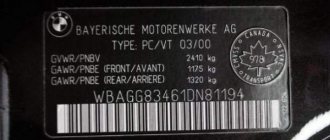↑ Schematic diagram of the battery voltage indicator
Rice. 1. Circuit of the motorist indicator Voltage divider R1 - R5 provides the required response thresholds of the comparators, selected as follows: - more than 14.8 V
- unacceptably high voltage (battery overcharging), which is dangerous due to boiling off of the electrolyte;
— 12.5...14.8 V
– normally charged battery;
— 11.8…12.5 V
– the remaining charge allows you to operate the battery (extend further discharge);
— 10.8…11.8 V
– it is necessary to urgently recharge the battery to avoid sulfation;
- less than 10.8 V
- “we are losing it.”
It is necessary to restore the battery and resolve the issue of its further operation. illumination of two indicators at the same time is excluded
Fig.
2. Front panel of the indicator Calculation of the divisor.xls
Fig. 3. Another option for the front indicator panel
Rice. 4. Indicator response threshold levels for monitoring the battery while the engine is running
When using a probe, you cannot ignore Murphy's law, which dictates that everything that can be confused will be confused. Everything that cannot be mixed up will also be mixed up. To protect against incorrect connection of the indicator to the battery, diodes VD1 and VD2 are installed. Motorist indicator parameters:
How does the charge indicator work?
How to check the density of the electrolyte in the battery and its level
The indicator on the battery, which was discussed above, is a simple hydrometer. It is designed to display the condition of the battery and approximate assessment of its readiness for operation. To better understand how to use it, let’s briefly consider the principle of operation of this indicator.
Battery status eye
Such indicators have different designs, but they all have the same operating principle, based on the floating floats rising at a certain electrolyte density. Let's consider a single-float design.
Design of a single-float hydrometer
From the figure we see that a green ball, having a given weight relative to its size, floats at a certain density of the medium and sinks if the density of this medium decreases. Let’s assume that the density of the electrolyte (and this is the medium) is normal; for a charged battery it is approximately 1.27. The ball floated up, and the light guide reflected its presence on the surface. We saw a green “eye” - the battery is OK.
As the battery discharges, the density of the electrolyte in it decreases. At a certain moment (for the ball, of course) it becomes critical, and the ball sinks. The conical light guide lens does not see it, but looks at the hydrometer body, which is made of black plastic. What does this mean? As a result, we observe a black “eye” - the electrolyte density is low, which means the battery is discharged to a certain extent. To what extent depends on the density at which the ball sinks.
That is, we have two options: the battery is normal or discharged. But there is a third option: the electrolyte level is very low. In this case, regardless of the density, the ball cannot reach its place at the light guide, but the light is reflected not from the black body of the hydrometer, but from the reduced level of electrolyte. We see a completely different color. It is usually white, but if the electrolyte is dirty it can change from yellow to light gray. In any case, it is impossible to confuse it with any other test.
There is another version of the hydrometer - a two-float one. Here two balls are involved in the work: green and red. The main difference from the single-float system is the presence of a ring prism that transmits the image to the light guide. As it rises, a ball of one color or another appears in the field of view of the prism. If he rises even higher, then he will leave her field of vision.
Depending on the density of the electrolyte, one or another ball appears in the field of view of the light guide; when the level drops critically, not a single ball is visible: one is located too low, the other is too high.
Renault Kaptur chocolate › Logbook › Information about the indicator on the battery
Information about the indicator on the battery To be honest, this indicator is created only to signal you about your battery, because as a rule, their design is not collapsible, and therefore you cannot climb inside and see what is with the electrolyte - just check its level or measure its density.
Indicator modes The following combination is very common: - green, white, black. However, some manufacturers use the following combination: green, white, red. But essentially it's the same thing. Let's go through these readings.
Many motorists are faced with a problem when the battery is fully charged, but the red indicator does not change to green. There are three reasons why this could happen:
- The design uses special balls, and a situation often arises when they get stuck and cannot jump to the surface. In this case, you need to shake the battery and the indicator will show the desired color.
- The device has dirt from the plates, which prevents the correct transmission of information. This is due to the fact that the plates in any battery can crumble over time. Then the electrolyte becomes cloudy.
- It is possible that the device has malfunctioned and cannot charge properly. In this case, you need to contact specialists.
If necessary, you can remove the indicator yourself. In most cases, this can be done with simple pliers, but this “procedure” is unsafe. There is a possibility that the airless space inside the device will be disrupted. This will lead to the leakage of explosive gas. Therefore, it is recommended to think carefully about the need for such an action before starting it.
Types of battery charge indicators
How to increase the electrolyte density in a battery at home
Battery charge controller
Indicators are divided according to the method of connection and signal indication. Charging is a complex process, so basically the indicators only inform about the end of charging in analog or digital form.
Each type of battery requires adequate charging circuits and designs, either electrical or electronic. So, for phones and laptops, pulse charges are used, which must have intelligence; they use microprocessors. The Weswen PWM electronic controller is used to charge batteries for independent power supply to homes.
One of the simple ones is the built-in battery charge indicator, which is made in the form of a peephole. Installed in one of the car battery cans. A variation of the indicator with two balls is shown in Fig. below.
Built-in battery charging indicator
The indicator is a plastic cylinder with floating green and red balls. The indicator uses the principle of a hydrometer. The red ball reacts only to the electrolyte level, the green ball – to the level and density of the electrolyte. There are also options with one green ball.
Electrical measuring indicators in the form of pointer voltmeters are also used. One of them is shown in Fig. below. Connected in parallel in the battery circuit.
Electrical battery voltage indicator
Installed both on the dashboard and in a convenient place. At normal battery voltage, the arrow should be within the last green sector. If the arrow shows below 75%, then recharging is required. Finding the arrow at the beginning of the scale (red sector) indicates that the battery is faulty.
Experienced battery owners can use simple ready-made digital indicators. One of these is shown in Fig. below
Digital voltmeter
It simply shows the voltage at a given time. It is up to the owner to decide what to do. When diagnosing a battery, you can use a dial or digital tester.
Radio amateurs can use a DIY display. Basically, circuits of various indicators are made to monitor the battery charge using light indicators, two or more. The circuit design of the display devices depends on the complexity of charging.
Important! The simpler the charging, the more complex the display circuit should be. On rice
Below is a diagram of checking the state of charge on 5 indicators
In Fig. Below is a diagram of checking the state of charge using 5 indicators.
LED voltage control circuit
The figure shows one of the possible electrical circuits, assembled on an Lm339 comparator with temperature compensation. HL1 will light up when the battery is undercharged or bad. HL2 is undercharged, which means it needs charging. HL3 – voltage is normal. HL4 – small recharge. HL5 – unacceptable overcharge. It is necessary to stop charging when HL4 lights up.
It should be noted! During operation, only one indicator light will be on. You can develop as many such auxiliary boards as your knowledge and needs require.
In modern gadgets that use power from rechargeable batteries, charging is made more complex in order to create optimal battery operating conditions. For example, in chargers for screwdrivers, pulse units using programmed controllers are used. In such automatic charges there are two indication states: discharged and charged. For convenience, liquid crystal indicators are also used as light indicators.
In modern cars, the condition of the battery is monitored by the main module, the engine control module and a sensor that monitors the battery parameters. The car's electronic system itself monitors the proper operation of the battery. The driver can only observe the information on the display screen.
The use of batteries for autonomous power supply to homes is being developed. Wind generators and solar panels are combined into a common power grid, and the batteries are controlled using a PWM controller, for example, from WESWEN.
It is necessary to constantly monitor the performance of the batteries. This is what charge indicators are designed for. Simple devices simply monitor, and controllers control and manage battery recharging.
Safety rules when charging a car battery.
How to change the electrolyte in a car battery
It is not recommended to charge in a residential area due to the fact that explosive gases are released from the battery. This is true for serviced batteries with plugs.
For the same reason, it is prohibited to smoke or perform any other work with open fire or sparks.
First, the charger is connected to the battery terminals, and then it is connected to the network. Disabling is done in reverse order. First, disconnect the charger (charger) from the network, then disconnect the terminals. This procedure will avoid the formation of a spark when connecting the charger to the battery.
Be sure to unscrew all plugs in batteries being serviced. This can be conveniently done using a regular coin of 2 or 5 rubles. After unscrewing, the plugs must be put back into the holes, but not tightened. This position of the plugs will allow gases to escape freely and at the same time protect the battery from possible dust and dirt getting into it. This will also reduce the loss of electrolyte during evaporation.
The plugs are unscrewed and inserted into their sockets.
Before unscrewing the plugs, be sure to wipe off all dust and dirt from the working surface of the battery. This will also prevent dirt from getting inside the battery.
If the battery is charged in an apartment, then it must be done on a balcony with an open window or in a room where there is an exhaust hood, for example, a toilet.
Possible errors
You should not rely 100% on the accuracy of the indicator eye in the design of a car battery. Motorists often note that this system for determining the condition of the battery has errors. This does not always accurately reflect the current state of affairs.
There are several reasons for errors:
- The density of the liquid inside the battery is affected by temperature. In extreme cold, the density increases. Because of this, a green ball may be observed in the eye, although in fact there is a strong discharge.
- High temperatures can affect the status of the indicator. The design usually involves the use of plastic and glass. The materials are quite fragile and can become deformed due to cold and heat.
- The battery usually has 6 sections or cans. But the indicator is located in only one of them, and the general condition of the battery is determined by only one bank. It is unknown how things stand in all other sections. The parameters may differ significantly and thereby negatively affect the condition of the power supply.
The only task facing the motorist is to open the hood and look through the peephole. If what you see clearly does not suit you, you need to take measures to normalize the condition of the battery.
Factory battery charge indicators
Today on sale you can find quite interesting devices for monitoring the battery charge level by its voltage. Let's look at some of them.
Battery charge level indicator DC-12 V
This device is sold as a construction kit. It is suitable for those who are familiar with electrical engineering and a soldering iron.
The DC-12 V indicator allows you to check the charge of the car battery and the functioning of the relay regulator. The indicator is sold as a set of spare parts and can be assembled independently.
The cost of a DC-12 V device is 300-400 rubles.
Main characteristics of the DC-12 V indicator:
- Voltage range: 2.5─18 volts;
- Maximum current consumption: up to 20 mA;
- Dimensions of the printed circuit board: 43 by 20 millimeters.
Panel with indicator from TMC
This indicator may be of interest to those who have installed .
The device is an aluminum panel with a voltmeter and a toggle switch for switching between batteries. Made in China and costs about 1,500 rubles.
A battery charge indicator is a necessary thing in the household of any motorist. The relevance of such a device increases many times over when, for some reason, a car refuses to start on a cold winter morning. In this situation, it’s worth deciding whether to call a friend to come and help you start from your battery, or whether the battery has died for a long time, having discharged below a critical level.
A car battery consists of six batteries connected in series with a supply voltage of 2.1 - 2.16V. Normally, the battery should produce 13 - 13.5V. Significant discharge of the battery should not be allowed, since this reduces the density and, accordingly, increases the freezing temperature of the electrolyte.
The higher the battery wear, the less time it holds a charge. In the warm season, this is not critical, but in winter, side lights forgotten while turned on can completely “kill” the battery by the time it is returned, turning the contents into a piece of ice.
In the table you can see the freezing temperature of the electrolyte, depending on the degree of charge of the unit.
| Dependence of the freezing temperature of the electrolyte on the state of charge of the battery | ||||
| Electrolyte density, mg/cm. cube | Voltage, V (no load) | Voltage, V (with load 100 A) | Battery charge level, % | Electrolyte freezing temperature, gr. Celsius |
| 1110 | 11,7 | 8,4 | 0,0 | -7 |
| 1130 | 11,8 | 8,7 | 10,0 | -9 |
| 1140 | 11,9 | 8,8 | 20,0 | -11 |
| 1150 | 11,9 | 9,0 | 25,0 | -13 |
| 1160 | 12,0 | 9,1 | 30,0 | -14 |
| 1180 | 12,1 | 9,5 | 45,0 | -18 |
| 1190 | 12,2 | 9,6 | 50,0 | -24 |
| 1210 | 12,3 | 9,9 | 60,0 | -32 |
| 1220 | 12,4 | 10,1 | 70,0 | -37 |
| 1230 | 12,4 | 10,2 | 75,0 | -42 |
| 1240 | 12,5 | 10,3 | 80,0 | -46 |
| 1270 | 12,7 | 10,8 | 100,0 | -60 |
A drop in charge level below 70% is considered critical. All automotive electrical appliances consume current, not voltage. Without load, even a severely discharged battery can show normal voltage. But at a low level, during engine startup, a strong voltage drop will be noted, which is an alarming signal.
It is possible to notice an approaching disaster in a timely manner only if an indicator is installed directly in the cabin. If, while the car is running, it constantly signals about discharge, it’s time to go to the service station.
Errors in the indicator's operation
You should not unconditionally believe the indicator and completely rely on it. Judging by numerous reviews from car enthusiasts, there are errors in its operation, and it does not always show the actual condition of the battery. The reason may be the following:
- the density of the electrolyte changes depending on the temperature - cold increases its density, and the indicator will show the norm even though the battery is actually almost discharged;
- glass and plastic parts of the device may be damaged due to high temperature and affect its accuracy;
- the battery consists of 6 banks, and the device is installed in only one and displays data only on it, the situation in the remaining banks may differ significantly and affect the overall operation of the entire battery.
Car enthusiasts note another drawback of such an indicator - to check the charge you need to open the hood and look under it. Of course, it is much more convenient when the data is displayed directly inside the car.
Characteristics of the battery charge level indicator
On modern cars with an on-board computer, the driver has the opportunity to obtain information about the level. Older models are equipped with analog voltmeters, but they do not reflect the true picture of the battery's condition. Battery voltage indicator (VIN) is an option to have operational information about the battery voltage.
Purpose and device
The IN is assigned two functions - to show how the battery is charged from the generator, and to inform about the amount of charge of the car battery. The easiest way is to assemble such a device with your own hands. The circuit of the homemade device is simple. Having purchased the necessary parts, it is easy to assemble the indicator with your own hands. This way you can save money, since the cost of the device is low (the author of the video is AKA KASYAN).
Operating principle
The charge level indicator has three LED lights of different colors. Usually these are: red, green and blue. Each color has its own informative meaning. Red color means low charge, which is critical. Blue color corresponds to operating mode. Green color indicates the battery is fully charged.
Varieties
IN can be placed on batteries in the form of a hydrometer or in the form of separate devices with an information display. Built-in IDs are usually placed on. They are equipped with a float indicator (hydrometer). It has a simple design.
Built-in IN design
Factory identification numbers are available:
- DC-12 V. The device is a construction set. With its help, you can monitor the charge of the battery and the performance of the relay regulator.
- For those who have a car equipped with a second battery, a useful device will be a panel with an indicator from TMC. This is an aluminum panel with a voltmeter placed on it and a switch from one battery to another.
- ID Signature Gold Style and Faria Euro Black Style - determine the battery charge level. But their cost is too high, so there is little demand for them.
Why do you need a peephole on a car battery?
The battery is used not only to start the engine, but also as a source of energy for a variety of on-board equipment. The normal voltage value is approximately 13.5 V. If it drops below 9 V, it means that the situation has become critical and the battery requires an urgent charge. But how can you find out about an impending discharge if the battery is still performing its functions, or the car has been standing for a certain period of time?
Experienced drivers or those who like to tinker with their car usually have a voltmeter or multimeter in the garage. By connecting its terminals to the battery current terminals, you can periodically monitor the voltage level. However, nowadays drivers rarely purchase such devices for themselves, with the possible exception of professional auto electricians. That is why battery manufacturers began to install simple but useful hint indicators inside the case.
Many models of car batteries from the above-average price segment today are equipped with a special light eye. Not all car enthusiasts know what this peephole means. In fact, the main purpose it serves is to give an idea of the state of charge and discharge of the device.
It all started with the fact that most modern car batteries moved from the maintenance-free category to the maintenance-free category. On the one hand, this made life much easier for drivers. On the other hand, it was impossible to establish the amount of charge, electrolyte density or level without opening the case. But the color signal given by the built-in light will help the driver assess the condition of his battery.
Why may the green light not light up after charging?
Some people are faced with the fact that even after a long period of charging, the color of the eye does not turn green. There are several reasons for this:
- the green ball is simply stuck in a narrow passage and does not fit into the right place - lightly shake the battery to move it;
- dirt from the plates, which crumble over time, prevents the indicator from showing the correct value;
- the battery has failed.
The peephole on the battery is a convenient way to check its charge level, but many car enthusiasts argue that this is a useless gimmick and you shouldn’t completely rely on its values. To accurately check the charge, it is better to measure the voltage using a load plug.
What color does the battery indicator light up depending on its condition?
What color should the indicator be for a charged battery?
The indicator is red – is the battery completely discharged?
Why is there no color on the battery indicator at all?
The battery status indicator can light up in three primary colors - red, white (colorless) and green.
- If the battery indicator glows green and there is a barely noticeable red light in the middle, this means that the battery is infected and the electrolyte density is normal.
- If the indicator has no color (white), this indicates that the battery needs to be recharged. As a rule, this is better done by a charger (rectifier) because the generator does not always produce the required current.
- Well, the third color option for the battery indicator is red. If the indicator light turns red, this means you need to check the density of the electrolyte, add distillation if necessary and charge the battery until it is fully charged.
On most modern batteries that are installed in vehicles, you can find a special light that glows in different colors, depending on the condition of the battery. If the battery indicator lights up red or another color, you can draw conclusions about the charge level of the device. It happens that inexperienced drivers are not aware of this feature.
Operating principle
Hydrometers function as follows:
- As a result of charging the battery, the density of the electrolyte increases. The appearance of a green signal indicates that the battery charge level is greater than 65%. In this case, the voltage is more than 13 V.
- If the red indicator on the battery is on, the vehicle owner should take care of charging. The indicator indicates a voltage whose maximum value reaches 11 V.
- The blue signal occurs at a voltage that varies from 11 to 13 V.
If the electrolyte level drops sharply, the car owner will have to add purified water to the battery. If the battery is in poor condition, this procedure will be much more difficult. A built-in indicator will be the best option for drivers who prefer to know the preliminary battery charge level.
It is necessary to understand that the values produced are not always accurate. When using such devices, batteries often become unusable. When the green indicator on the battery lights up, the battery is fully charged.
The removable indicator can be placed in the car interior, within the driver’s visibility range. Most often, the device is placed near the steering column. The advantages of such an installation include the suitable location of the LEDs, the absence of problems with control and connection to the ignition system.
Built-in car battery indicator
If the battery charging indicator does not light up, the car owner should pay attention to the condition of the light bulb and the battery itself. The first one may burn out, and the second one may suffer from reduced energy efficiency. To solve why the battery indicator is green and the battery is low, you need to visit a service center. It is not recommended to carry out repair work yourself in the absence of special knowledge and relevant experience.
Color designations and How it works
Almost every car owner is familiar with the situation when, for no apparent reason, the car does not start, and later it turns out that the reason is a discharged battery. To avoid this, you need to monitor the charge level, and to check you just need to look under the hood.
Why do you need a peephole on a car battery?
Many car batteries are equipped with a special device that measures and shows the state of charge of the battery. The built-in charge indicator is located on the front (top) side of the device and looks like a peephole - by looking at it, the car owner quickly understands that everything is in order or that recharging is necessary.
How the indicator works and how accurate it is
Under the small eye lies a built-in aerometer (a device that measures the density of a liquid). There is electrolyte inside the battery and, by measuring its density, the device tells whether there is a need for charging.
Device structure
An aerometer is a small tube at the end of which there is a float in the form of a colored ball. If the battery is well charged, the electrolyte density is high, and the ball rises to the top. This is what the car owner sees through a magnifying glass.
If the charge is insufficient, the density of the electrolyte drops and the green ball sinks. Instead, only the black tube of the device is visible and the eye appears black. In addition to the green one, some batteries also have a red ball. It is this that floats to the top when the density decreases, replacing green.
In addition to insufficient charge, the battery may have a lack of electrolyte. In this case, the surface of the liquid is visible in the eye, and the indicator becomes white.
Errors in the indicator's operation
You should not unconditionally believe the indicator and completely rely on it. Judging by numerous reviews from car enthusiasts, there are errors in its operation, and it does not always show the actual condition of the battery. The reason may be the following:
- the density of the electrolyte changes depending on the temperature - cold increases its density, and the indicator will show the norm even though the battery is actually almost discharged;
- glass and plastic parts of the device may be damaged due to high temperature and affect its accuracy;
the battery consists of 6 banks, and the device is installed in only one and displays data only on it, the situation in the remaining banks may differ significantly and affect the overall operation of the entire battery.
Car enthusiasts note another drawback of such an indicator - to check the charge you need to open the hood and look under it. Of course, it is much more convenient when the data is displayed directly inside the car.
Color designations
The battery eye has three colors - green, white and black, depending on the battery charge and the state of the electrolyte. Some devices use another color - red. Each color has its own meaning, thanks to which the car owner understands whether the battery is charged or discharged.
- Green indicator on the battery. If the eye is green, you can rest assured. This means the battery is charged and does not need to be recharged. You can use the car as usual.
- Red indicator on the battery. The red eye is an alarm signal informing the motorist that the battery is discharged and requires urgent recharging. In this case, you need to immediately remove it from the car and fully charge it.
- Black indicator on the battery. The black eye has the same meaning as the red one. The density of the electrolyte has decreased, the green ball has sank, and you see the blackness of the tube in the eye. Requires charging.
- White indicator on the battery. If the eye is white, it means there is not enough electrolyte in the battery. You can fix this yourself by disassembling the device and adding distilled water to it.
Why may the green light not light up after charging?
Some people are faced with the fact that even after a long period of charging, the color of the eye does not turn green. There are several reasons for this:
- the green ball is simply stuck in a narrow passage and does not fit into the right place - lightly shake the battery to move it;
- dirt from the plates, which crumble over time, prevents the indicator from showing the correct value;
- the battery has failed.
The peephole on the battery is a convenient way to check its charge level, but many car enthusiasts argue that this is a useless gimmick and you shouldn’t completely rely on its values. To accurately check the charge, it is better to measure the voltage using a load plug.
Varieties
Factory automotive indicators are classified according to the following indicators:
- Connection method. The device can be connected using the on-board network or the cigarette lighter connector.
- Signal display. The device can be digital or analog.
The operating principle of all indicators is quite similar. Devices for batteries are made in the form of information displays and hydrometers. Instead of standard models, you can use indicators made by other manufacturers. They are quite easy to place in the car.
Schematic design of the battery charge indicator
Indicator values
Now you need to understand the colors of the indicator on the battery and understand what each of them means.
If you study the design features of modern maintenance-free batteries, you will notice that 3 colors are usually provided as indicators. It's black, white and green. They display the degree of charge and the state of the electrolyte. But on some batteries there is also a red color.
Each indicator, depending on the color, has its own meaning. They can tell you what problems there are in the battery:
Green. You should start with the green indicator on the battery with a viewing eye. If you see this color when studying the condition, everything is fine. Green indicates that the charge is full, there is no need to put the battery on the charger. You can safely continue to operate the machine as normal.
Red. Next we will talk about the red indicator on the battery. Traditionally an alarming color for a motorist. A battery with a red eye is no exception. This color indicates that the power source is very discharged, and it is recommended to connect it to a charger as soon as possible. The probability of starting the engine with this battery condition is quite low.
Black. Motorists are interested in what to do if the eye on the car battery turns black. Usually this color is an analogue of red. And therefore it means the same thing. The density of the electrolyte is low, which is why the green ball sank. In the peephole you see black tubes. Immediately place the battery on the charger.
White
It is equally important to understand what the white indicator on the battery says. This color indicates a deficiency of electrolyte inside the battery.
You can correct this situation at a car service center, or disassemble the case and add distilled water yourself.
Now you know what to do if your battery indicator under the hood of your car lights up red, black, or green. These colors indicate the charge level.
The situation is different if the indicator in your battery is white. It means that there is a shortage of working fluid inside the housing. This happened as a result of active boiling of the electrolyte or due to a leak. First you have to carefully examine the condition of the case. Make sure the problem is not a deformed battery. The electrolyte, or rather its water component, can evaporate and come out gradually through special excess pressure relief valves. In maintenance-free batteries, evaporation is minimal, but it is still possible.
Although it is believed that it is structurally impossible to add water to maintenance-free batteries, this is actually not the case. There are several ways to do this, including drilling holes. Although the latter method is still not recommended.
Before testing by examining the color of your battery indicator, carefully examine the case. The manufacturer usually writes which color indicates what. This will allow you to understand how to correctly identify a full charge or discharge specifically in the case of your power source. After all, someone plans to use green, white and black. Others have green, red and white indicators.
What does the indicator mean?
Different indicator symbols on the battery carry different meanings. This is expressed in the color that the light bulb is lit at one time or another. The main combinations used by battery manufacturers are green, white, black (or red instead). It makes sense to take a closer look at what each of these colors means.
So, the main values will be:
- The green indicator on the battery is the best and most joyful for the driver.
- The white indicator does not bring very good news. This means that the battery's electrolyte level is too low. This happens when there is excessive overcharging, when the electrolyte is thrown out of the cans and turns into a gaseous state. There is only one way out - to disassemble the battery and add fresh electrolyte, but this is only suitable for serviceable batteries;
- The red indicator (on most devices it is black) is an indicator of a critical charge level, which tells you that you urgently need to recharge the battery. If nothing is done, the device may completely stop producing current.
At its core, if the light is white, then this indicates that the control ball is at the bottom of the housing. This can happen because there is practically no electrolyte left in the jar. For the indicator, this liquid is nothing more than a conductor.
These are the main values or colors that the driver operating the vehicle should periodically pay attention to. However, the indicators are not perfect and can sometimes only roughly reflect the actual state of the battery. It is impossible to find out the exact charge percentage at all. And it is not possible to understand that the battery is 50% or 100% discharged. Therefore, you need to handle this complex device with care, store it correctly when removed, and prevent complete and frequent discharge.
Guide to making a device at home
The simplest and cheapest option is a self-made IN. Its purpose is to control how the voltage in the on-board network works within the range of 6-14V.
The following parts will be needed for the diagram:
- printed circuit board;
- resistors: 2 with a resistance of 1 kOhm, 1 with a resistance of 2 kOhm and 3 with a resistance of 220 Ohm;
- transistors: VS547 - 1 and VS557 - 1;
- Zener diodes: one for 9.1 V, one for 10 V;
- LED bulbs (RGB): red, blue, green.
For LEDs, using a tester, you need to determine and check the pins so that they match the color. The device is assembled according to the diagram.
The components are tried on the board and cut to the appropriate sizes. It is advisable to arrange the components so that they take up less space.
Based on the manufactured device, it is impossible to determine specific battery voltage values; you can only navigate within what limits it is located:
- red lights up if the voltage is from 6 to 11 V;
- blue corresponds to voltage from 11 to 13 V;
- green means fully charged, meaning the voltage is greater than 13V.
The battery voltage indicator can be installed anywhere in the cabin. It is most convenient to place it at the bottom of the steering column: the LEDs will be clearly visible and will not interfere with control. In addition, the device can be easily connected to the ignition switch. After installation, the driver will be able to always know how charged his car’s battery is and charge his battery if necessary.
Price issue
If you buy a ready-made battery charging indicator, then the options presented below are possible.
Just recently a new Forse battery appeared under the hood. And here is the first adventure. The eye on the battery today noticed a black one. Just black. There is no color. The starter turns normally. There were no discharges.
I brought the charger. It took about 30 minutes to charge, and the charger said it was charged. But the peephole is still black.
I researched the structure of these eyes on the Internet. A primitive hydrometer. But it doesn’t turn green, most likely because the ball is stuck/stuck inside.
I'll try to stop by the store where I bought it soon. There is a guarantee. Let's see what they say.
Well, I think they’ll test it with a fork and say it’s ok. Then they will take it off and shake it a little. So that the ball floats up. That's where it all ends. I won't shake myself. This is their job. Let them do it. What if it really is a factory defect?
In winter it may become glitchy and appear green when the battery is low. But not the other way around. And mine is black. —————————————————- The problem disappeared on its own, just as it appeared. After a trip around the city, apparently due to shaking, the green ball floated up on its own. And it appeared in the peephole. Didn't do anything to him. It's worth remembering that this is possible. And that's okay. It's OK. You can shake the battery yourself, or look after a day or two after the trip and shaking. It happens that the ball inside can stick.
About a light bulb - not a light bulb
I wanted to write this information at the top, but it creates more intrigue. In the structure of this sensor, no light bulbs are used at all - neither ordinary incandescent (low-current) - as many people think, nor LED, nor anything else.
The structure here is different. In fact, this is an ordinary hydrometer, only built into the battery case. It automatically measures the density of the electrolyte, and at different values it pops up - one or another ball, which is projected through a magnifying glass tube and a magnifying glass into a special window
It should be noted that the balls float up as if along special grooves, which are made in the shape of a pyramid - this is important! REMEMBER!
If the battery is charged, a green ball floats up and you see it in the window. If it is discharged, then either red or nothing at all floats in, so you see blackness. But if there is no electrolyte, then the end of the pyramid seems to be exposed - you see its end in the window, many people confuse it with white.
The use of electrics in a battery would not be justified - even if the light bulb were low-voltage, it would still suck some of the energy from the battery (and in winter this is oh so unnecessary). YES, and if it burns out, the owner will start to get nervous.
Construction device
Many people mistakenly believe that such a device is made in the form of an LED light bulb. However, the design of this device looks different. In most cases, a special hydrometer is used, which is built directly into the battery case. This device allows you to accurately determine the density of the electrolyte in the device. Depending on the data received, a ball of a certain color floats up in the tube , after which it is projected onto a special window located on the surface of the device.
We recommend: Frequent car battery breakdowns and battery repairs
If the battery is fully charged, there is a green ball at the top of the tube, which can be seen in the window and mistaken for a light bulb. If the device is low, a red ball pops up. In the case of black color, no ball floats up, and black color is simply visible in the window.
The reason for using this design is that electronics in the form of a regular light bulb would not be suitable for this task, since they also require energy. Moreover, any light bulb can burn out. In this case, the device will stop performing its task.










